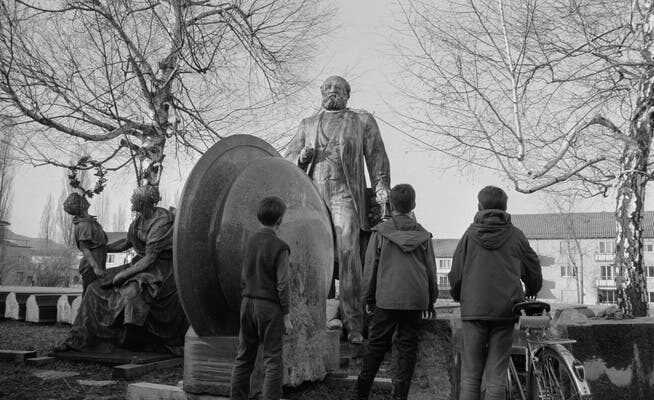The well-known historian Georg Kreis examined 38 monuments on behalf of the city of Zurich. He comes to the conclusion that no sensitive messages are transported with them and that they therefore do not have to be disposed of.
During the renovation of the station square, Alfred Escher was relocated to Wollishofen for a short time. Today its place at the train station is no longer endangered.
The role of monuments has been discussed worldwide in recent years. It started with the “Black Lives Matter” movement in the USA and the toppling of some monuments to men who had distinguished themselves as slave owners. As a result, the discussion also spilled over into Switzerland and Zurich. For example, the municipal council called for an investigation into the involvement of Zurich companies in slavery.
Alfred Escher’s Evil Uncles
The study, which was subsequently written at the chair of Gesine Krüger at the University of Zurich, uncovered a large number of connections between Zurich and slavery. With Alfred Escher, however, who was the focus of the investigations, a kind of all-clear sounded. Two of his uncles ran plantations in Cuba where slaves were kept. Escher himself was not involved.
Nevertheless, the department for art in public space was commissioned to examine Zurich’s monuments more closely as a whole. As a basis for the following decisions, the historian Georg Kreis was commissioned to shed light on the historical side of all those works of art in public space that are classified as monuments. Kreis has now examined 38 monuments and given an account of them in a 200-page report.
No “toxic legacy”
The report was actually announced for the beginning of the year, but when asked, it was repeatedly put off. Yesterday, a link to the study was published in the early afternoon. Of course, it was not possible for media representatives to read the entire report, let alone analyze it in detail. We are therefore basing the following on a media release from Wednesday and a summary in the report itself.
Georg Kreis is said to have found out that none of the monuments examined can be classified as sensitive – especially not if one takes the perspective that the monuments stand for certain values that are embodied in a person. In the case of Alfred Escher, the entrepreneurial achievement is honored, in the case of Richard Wagner, his musical work.
However, if one takes a comprehensive look at the honored persons, the expectation can already exist that these additional aspects will be made clear with references to the monument, according to the report. In the case of Escher, this could be a reference to his family’s fortune, some of which was acquired through slavery, while in the case of Wagner, it would be anti-Semitic statements. Incidentally, such sensitive aspects can also be found in the case of the Red Cross founder Henry Dunant, who took part in the colonization of North Africa in the early years.
Kreis points out that the vast majority of monuments are historical cultural assets. They would certainly not be built in this form today. With their original messages, they conveyed “no ideologies that, from the point of view of today’s ‘ordre public’, would have to be classified as reprehensible and disposed of as a toxic legacy”.
Continue to the monument strategy
The so-called contextualization of monuments, i.e. the reference to their origin and meaning, is repeatedly demanded. Kreis also takes up the idea and can imagine completing the task with the help of an app, QR codes or a comprehensive monument guide. However, he points out that the additional information on the monument could be perceived in later years “as an obtrusive and self-righteous instruction”.
The Zurich City Council “took note of” Georg Kreis’s report on Wednesday, according to the city’s press release. At the same time, the Art in Public Space department and the corresponding advisory commission were commissioned to develop a comprehensive monument strategy. The aim is to find guidelines for dealing with existing and new monuments. In addition, instruments are to be created to promote an active examination of the monuments and to establish connections.
